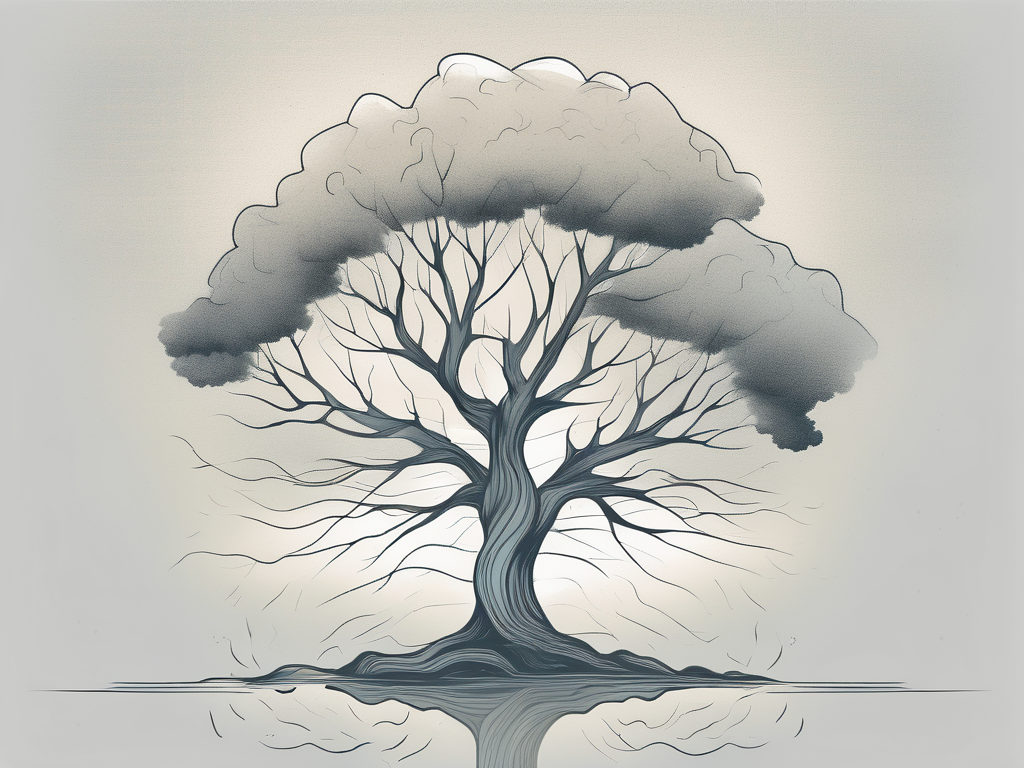In a world of chaos and uncertainty, finding inner peace and resilience is a journey many of us seek. One philosophy that offers practical guidance in achieving these goals is Stoicism. Although it may sound ancient, Stoicism is as relevant today as it was in ancient Greece and Rome.
Understanding the Basics of Stoicism
At its core, Stoicism is a philosophy that teaches us how to navigate life’s challenges with grace and fortitude. It emphasizes the power of our minds to shape our perception of events and reminds us that what truly matters is our response to adversity.
The philosophy of Stoicism is rooted in the belief that we have control over our thoughts and actions, while external events are beyond our control. By focusing on the things we can influence and accepting what is outside our control, we can cultivate resilience and inner peace.
Stoicism originated in ancient Greece and was further developed by Roman philosophers like Epictetus, Seneca, and Marcus Aurelius. It encourages individuals to align their values with the natural order of the universe, live in accordance with reason, and embrace virtues such as wisdom, courage, justice, and temperance.
Central to Stoicism are several key principles that guide its followers:
- Acceptance of the present moment: By accepting and embracing what is happening in the present, we gain power over our emotions and can respond calmly and rationally.
- Focusing on what is within our control: Stoicism teaches us to direct our energy towards the things we can influence, such as our thoughts, emotions, and actions, rather than becoming consumed by the uncontrollable external world.
- Practicing mindfulness: Stoics emphasize the importance of being fully present in each moment, continuously aware of our thoughts, and choosing to respond deliberately rather than react impulsively.
Stoicism offers a practical framework for living a meaningful and fulfilling life. By understanding and applying its principles, individuals can develop resilience, cultivate inner peace, and find purpose amidst the chaos of the world.
One of the key aspects of Stoicism is the concept of “Amor Fati,” which translates to “love of fate.” This principle encourages individuals to embrace and accept whatever happens in their lives, whether it be positive or negative. By loving and accepting our fate, we can find meaning and purpose in every experience, even in the face of adversity.
Another important aspect of Stoicism is the practice of negative visualization. This technique involves imagining the worst-case scenarios in our lives, not to induce fear or anxiety, but to prepare ourselves mentally and emotionally for any potential hardships that may come our way. By mentally rehearsing challenging situations, we can develop the resilience and fortitude needed to overcome them.
Stoicism also emphasizes the importance of self-discipline and self-control. By practicing self-restraint and moderation in our desires and impulses, we can avoid being controlled by external circumstances and instead focus on what truly matters. This discipline extends to our thoughts as well, as Stoics believe in the power of controlling our inner dialogue and choosing thoughts that align with reason and virtue.
Furthermore, Stoicism encourages individuals to live in harmony with nature and the natural order of the universe. By recognizing our interconnectedness with all living beings and the world around us, we can develop a sense of gratitude and appreciation for the beauty and wonders of existence.
In conclusion, Stoicism provides a practical and philosophical framework for navigating life’s challenges and finding inner peace. By embracing the principles of acceptance, focusing on what is within our control, and practicing mindfulness, individuals can cultivate resilience, develop self-discipline, and live a life of virtue and purpose.
The Role of Stoicism in Building Resilience
Resilience is the ability to bounce back from adversity, and Stoicism offers practical tools to develop this strength. But what exactly is Stoicism and how does it contribute to building resilience?
Stoicism is an ancient philosophy that originated in ancient Greece and was later adopted by the Romans. It teaches individuals to focus on what they can control and accept what they cannot. Stoics believe that by practicing self-discipline and cultivating a virtuous mindset, one can achieve inner peace and resilience.
The Stoic Approach to Challenges
Stoics view challenges as opportunities for growth and transformation. They remind us that obstacles are not setbacks but rather crucial turning points in our journey. By embracing challenges, we can develop resilience and emerge stronger.
When faced with adversity, Stoics encourage individuals to shift their perspective and see challenges as opportunities for personal development. Instead of viewing setbacks as insurmountable obstacles, Stoics believe in approaching them with a mindset of curiosity and a willingness to learn.
For example, imagine a person who has lost their job unexpectedly. Instead of succumbing to despair, a Stoic would see this as an opportunity to explore new career paths, develop new skills, or even start their own business. By reframing the situation, Stoics are able to find meaning and purpose in the face of adversity.
Cultivating Resilience through Stoic Practices
Stoicism suggests various practices to enhance our resilience, such as:
- Memento Mori: Reflecting on our mortality to gain perspective and prioritize what truly matters in life. Stoics believe that by acknowledging the inevitability of death, we are reminded to make the most of our time and focus on what is truly important.
- Negative Visualization: Imagining worst-case scenarios to prepare ourselves mentally and reduce fear of the unknown. By envisioning the worst possible outcomes, Stoics believe that we can mentally prepare ourselves for any situation and develop a sense of calm and resilience.
- Journaling: Writing down our thoughts and experiences to gain self-awareness and clarity. Stoics believe that by reflecting on our thoughts and emotions, we can better understand ourselves and develop the resilience to navigate life’s challenges.
In addition to these practices, Stoics also emphasize the importance of maintaining a sense of gratitude and practicing mindfulness. By cultivating gratitude for what we have and being fully present in the moment, Stoics believe that we can develop resilience and find contentment even in the face of adversity.
Overall, Stoicism offers a unique perspective on building resilience. By embracing challenges, shifting our mindset, and practicing various Stoic techniques, we can develop the inner strength to bounce back from adversity and lead a more resilient life.
Achieving Inner Peace with Stoicism
Inner peace is a state of tranquility and harmony within ourselves, regardless of external circumstances. It is a state of being that many of us strive to achieve, but often find elusive in the chaos of everyday life. However, Stoicism offers practical techniques to not only achieve but also maintain this inner calm.
Stoics advocate for practices such as:
- Practicing Gratitude: Focusing on what we have rather than what we lack, cultivating appreciation for the present moment. This practice allows us to shift our perspective and find joy in the simple things that we often take for granted. By acknowledging the abundance in our lives, we can cultivate a sense of contentment and peace.
- Practicing Detachment: Recognizing that our happiness should not depend on external factors and learning to detach ourselves from outcomes beyond our control. Stoicism teaches us that we have the power to control our own thoughts and actions, but external events are beyond our influence. By accepting this truth and letting go of our attachment to specific outcomes, we free ourselves from unnecessary stress and find a sense of inner calm.
- Meditation: Engaging in mindfulness meditation to quiet the mind, observe our thoughts, and find stillness within. This practice allows us to detach from the constant stream of thoughts and worries that often plague our minds. By focusing on the present moment and observing our thoughts without judgment, we can cultivate a sense of inner peace and clarity.
But what is the Stoic perspective on contentment? Stoicism teaches us that contentment arises from aligning our desires with what is within our control. It encourages us to focus on our inner virtues, such as wisdom, courage, and justice, rather than external circumstances. By accepting the natural order of the universe and recognizing that we cannot control everything, we can find lasting contentment.
Stoics believe that true happiness comes from within, and it is not dependent on external possessions or achievements. They argue that we have the power to choose how we respond to the events in our lives, and by cultivating a mindset of acceptance and gratitude, we can find peace even in the face of adversity.
Furthermore, Stoicism teaches us to embrace the impermanence of life and to appreciate the present moment. By recognizing that everything is transient and that change is inevitable, we can learn to let go of attachments and find peace in the ever-flowing river of life.
In conclusion, Stoicism offers valuable techniques for achieving inner peace. By practicing gratitude, detachment, and meditation, we can cultivate a sense of tranquility and harmony within ourselves. Additionally, by aligning our desires with what is within our control and embracing the impermanence of life, we can find lasting contentment. So, let us embrace the wisdom of the Stoics and embark on a journey towards inner peace.
Applying Stoicism in Everyday Life
Stoicism, unlike many other philosophies, is not limited to the realm of theory. It emphasizes practical application in our daily lives.
Stoicism is a philosophy that originated in ancient Greece and has since gained popularity as a practical philosophy for living a fulfilling life. It teaches individuals to focus on what they can control and accept what they cannot, leading to a sense of inner peace and resilience in the face of adversity.
By incorporating stoic principles into our lives, we can navigate the ups and downs with grace and wisdom. Let’s explore some practical exercises that can help beginners apply Stoicism in their everyday lives.
Practical Stoic Exercises for Beginners
Here are a few practical exercises you can try to incorporate stoic principles into your life:
- Morning Reflection: Start your day by reflecting on the things you can control and setting intentions for how you will respond to challenges. This exercise helps you cultivate a proactive mindset and prepares you to face the day with resilience.
- Observe Your Reactions: Throughout the day, pay attention to your reactions to events and consciously choose a stoic mindset. By observing your reactions, you can identify areas where you tend to get caught up in negative emotions and practice reframing your perspective.
- Seek Virtuous Role Models: Study the lives of stoic philosophers and other individuals who embody stoic virtues. By learning from their examples, you can gain inspiration and guidance on how to live a virtuous and meaningful life.
These exercises are just the beginning of your stoic journey. To truly integrate Stoicism into your life, it is important to maintain your practice consistently.
Maintaining Your Stoic Practice
Like any skill, practicing Stoicism requires consistency and perseverance. Here are a few tips to help you maintain your Stoic practice:
- Find a Stoic Community: Connect with like-minded individuals who share your interest in Stoicism, either through online forums or local meetups. Surrounding yourself with a supportive community can provide encouragement and valuable insights.
- Read Stoic Literature: Continually explore the works of ancient Stoic philosophers and modern interpretations to deepen your understanding and inspire your practice. Stoic literature offers timeless wisdom and practical advice for navigating the challenges of life.
- Regularly Reflect: Take time to reflect on your Stoic journey, the progress you have made, and areas where you can improve. Reflection allows you to gain self-awareness and make conscious adjustments to align your actions with stoic principles.
Remember, Stoicism is not a destination but a lifelong practice. By incorporating stoic principles into your daily life and maintaining your practice, you can cultivate resilience, inner peace, and a deeper sense of fulfillment.
The Benefits of Adopting Stoicism
By embracing Stoicism, you can experience numerous benefits that span various aspects of your life.
Personal Growth and Stoicism
Stoicism provides a framework for personal growth by encouraging self-reflection, setting virtuous goals, and maintaining a disciplined mindset. Through Stoicism, you can cultivate qualities such as resilience, wisdom, and emotional intelligence.
Stoicism and Mental Health
Stoicism offers an invaluable perspective on managing our thoughts and emotions, making it a potent tool for improving mental health. By developing resilience and accepting what is outside our control, we can reduce stress, anxiety, and find greater peace of mind.
Embracing Stoicism is not about detaching from life or suppressing emotions. It is about understanding our own agency, choosing virtue over vice, and finding peace even amidst chaos. So, if you’re eager to embark on a journey towards resilience and inner peace, Stoicism may just be the path you’ve been searching for.












